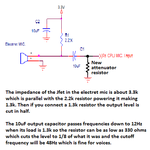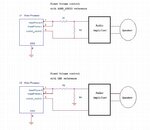panneerrajan
Member level 1
- Joined
- Jul 9, 2013
- Messages
- 38
- Helped
- 0
- Reputation
- 0
- Reaction score
- 0
- Trophy points
- 6
- Location
- Trivandrum
- Activity points
- 350
HI,
I have used electret mic and its output connected to 2.2k pullup resistor with vcc3.3V and series 10uF Alu.El. Capacitor than its connected to CPU MIC input channel
It has sensed 5 meters voice also, so i received unwanted noise. But my requirement voice to be sense maximum 1 meter only.
How to reduce mic sensing level? Pls suggest me
Rajan
I have used electret mic and its output connected to 2.2k pullup resistor with vcc3.3V and series 10uF Alu.El. Capacitor than its connected to CPU MIC input channel
It has sensed 5 meters voice also, so i received unwanted noise. But my requirement voice to be sense maximum 1 meter only.
How to reduce mic sensing level? Pls suggest me
Rajan





